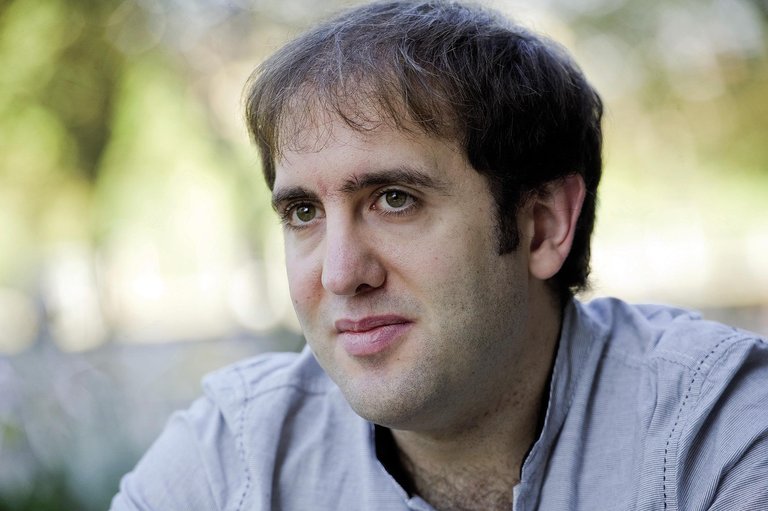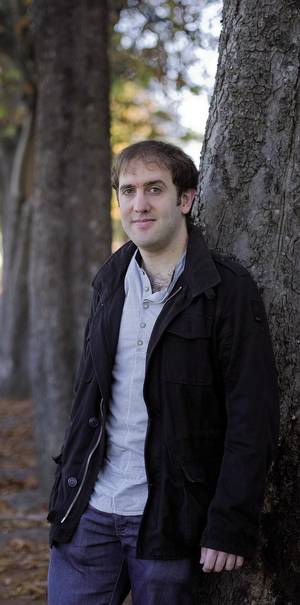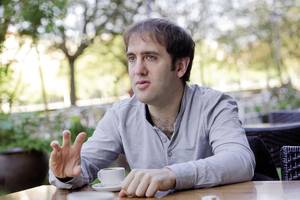“Rosetta is very special: it’s like having a window in space”

When I left college, I did a master's degree and started as an intern at Indar. Being there, I sent a resume to job offers and received me in an engineering from Madrid, at GMV. I am originally employed by that company, but I work for ESA.
For me, the dream has been to come true. I studied aeronautical engineering and specialized in space engineering. I didn't have much expectation of working on it, because there are no space-related industries here, but the crisis forced me to look for work outside and now I'm working for ESA. It makes me very excited.
I am in the Flight Dynamics department, specifically in the area of interplanar missions. Four missions are being carried out in this area: Mars Express, Venus Express, Gaia and Rome. And in the coming years there will be others: BepiColombo, LISA Pathfinder... Each mission has a team of controllers that have the mission of sending general commands or commands to the spacecraft, for example, to turn on or off instruments or to keep the thermal system in good condition. We send the Flight Dynamics commands and participate in more than one mission. I am three times: BepiColombo, Gaia and Rosetta, each in a different phase.
Yes, it's amazing. When I entered, I started preparing what the BepiColombo mission will be. Their goal is Mercury, and although the launch is planned for August 2016, in many cases it is about delays.
It is not an easy mission, as Mercury is very close to the Sun, so it has a very advanced thermal system. In addition, you will have to travel a seven-year route: first you will leave the Earth, then you will approach the Earth, you will pass twice through Venus and five times through Mercury to go down the speed. In fact, if you were traveling live, you would reach the target with too much speed, so the designed route is quite rolled up. We are now preparing the software to send orders quite automatically.
The theme was sent in December last year, so a year will shortly develop. It is a telescope whose objective is to catalogue the stars of the milky way. They say it is the most powerful digital camera that has been installed in space and is in a special place. Three times the distance between the Earth and the Moon, there is a point aligned with the Moon and the Sun. It is point L2. Between Earth and the Sun there are five points where the forces of attraction between Sun and Earth are neutralized and you can leave a spaceship still. Now Gaia turns around point L2 taking pictures. Thus, we have now begun to do science or receive results.
And Rosetta is in the last two years of his life. Rosetta ends when comet 67P/Churyumov-Gerasimen reaches its lowest distance to the Sun. Meanwhile, it has very interesting tasks, including the current one: Phila will land in a coma on November 12. But then it will continue to work. In fact, as we approach the Sun, the activity of the comet increases and Rosetta will continue to do so. The comet will be closer to the Sun in December 2015 and until then we will see how its activity increases and how it reaches its maximum.
Indeed. It was launched in 2004 and, like in BepiColombo, had a complicated route: He left the Earth and flew over the highest of Mars, then passed through the asteroid belt and had the opportunity to study two of them, Steins and Lutetia.
Yes, the most beautiful thing about this mission is that we are seeing what she sees, because she takes pictures. The rest of the probes usually navigate blindly and do send data, but at first glance you see little. But Rosetta takes pictures. It's like having a window in space, and that generates a lot of emotion. Rosetta is very special in this regard.
And the comet is also special. Or at least it is very different from what they expected. They didn't know how it was going to be; they thought it was going to have a potato shape, but in no case did they expect to have a two-part body. In the initial photos they found that they were two bodies. There was a shadow in the center and it didn't look good, and then they saw it's paton-shaped.
So at work we laughed a lot. To mark the first point of the comet was used a yellow plastic duck, which is located there. We also have another printer, better, and the last one is the best and the largest, but we save them all. It looks like a family of duck [laughing]: one bigger, one smaller and the third, the smallest, a plastic duck.
However, when I entered we had no ducks. Rosetta was in hibernation and until she woke up, there was a lot of expectation, because we didn't know she was going to wake up. In the end everything went well, but it was a critical moment. In addition, the signal came half an hour after expected, which caused nervousness. Then they realized that every time the system was restarted, the clock added a few seconds and that every time the delay was restarted it increased. At that time people were very nervous. I worked with a Gaia mission theme and suddenly heard screams and applause from the people, and then I discovered that Rosetta woke up.
Indeed. We are a lot of people because it is the most significant mission of ESA and it is using all the resources it can. For example, in my group almost all of us are with Rosetta, if in one thing it is not in another.
The process is quite long. We are divided into six groups. The first, analyzing the signals sent by Rosetta, and sometimes even with the help of the telescope, calculates the position and speed of Rosetta. The second group makes a travel forecast that already includes maneuvers. For example, to get close to the comet you have had to do a lot of maneuvers to lose speed and change the route. Then another group confirms the calculations.
Then the process of converting the calculations into commands for Rosetta, and there I am. First, a group analyzes Rosetta's orientation and we come next: knowing where he is, where he has to go, what his orientation is and how he will go, we have to translate the commands into the language that Rosetta will understand. That is my function.
In short, we know the system, for example, we know where the rocket has to maneuver; we can control the inertial wheels that control the orientation, accelerating or braking them to take the orientation we want... Therefore, the general information that comes to us is made available to the Rosetta systems. To perform the calculations we take into account enough parameters and test them in a simulator. Below is another group that states that the work we have done is correct. This ends the process. We passed the commands to the controllers, they to Rosetta and it is already.
In this Rosetta is an exception, since we also control the cameras, even if half. One of the novelties of Rosetta is its optical navigation. Some of the cameras take scientific photos, but another, NAVCAM, is the navigation camera. And we control that. We have to know where it is and what its orientation is and how far from Earth we cannot see it from Earth. To do this we use the photos sent to us by the probe.
And to navigate with the precision that Rosetta has to navigate, conventional systems are insufficient, we also need optical navigation, and for that you have that camera. Therefore, in the Rosetta function schedule we leave some margins to take the photos we need with NAVCAM.
In the Rosetta mission, the most difficult thing is that you can work at the pace of the process. As I explained before, at work we have a cycle and a deadline. We command twice a week, at eight in the morning they begin to prepare the data and when my turn arrives it is usually about an hour. I usually have no problems and I have the job finished for two hours. But if there is an error, to locate the error and correct it, you do not know how long you will take and you cannot postpone it. That's the hardest thing. However, we almost never have problems, but the responsibility is there.
People are very nervous. We held two weekly meetings, before Rosetta maneuvers, as all teams come together. And in those meetings it is noted that as the time comes to send Philae, there is increasing tension. The tension is positive, but yes, we cannot deny that we are nervous.
It is true that the mission does not end there. It is a very significant part of the mission, but not the only one. Just getting here, that is, putting a probe into the orbit of a comet is impressive. It is the first time a comet is analyzed so closely and followed as it approaches the Sun, and who knows when a similar mission is to be performed.
In any case, Phil's is certainly a milestone. We all know that if it goes well, we will be guaranteed work for the coming years. And, if not, it will be something we will remember throughout our life.
Now we are simulating the landing of Philae, with which we also tested the commands. The Rosetta route is being designed in parallel. At some point we will prepare Rosetta to be 5 km from the comet, but it will not approach so much. Halfway, about 20 km, let go of Philae and with a maneuver changes direction and moves away. For what? For as long as it arrives and lands the surface of comet Philae to follow up from Rosetta. For example, the comet path is ballistic and will last eight hours. Meanwhile, Rosetta takes pictures. Now, in the simulation, we will ensure that Rosetta always has Philae in sight and will take the photos well.
One of the biggest difficulties is that the kite has very low gravity, so although Phila has a mass of 100 kg, on the surface of the kite only weighs a few grams. This means that the kite hardly attracts. To overcome it, it has cold gas rockets to “stick” on the surface and anchors on the legs.
What can happen? If it comes too fast, there is a risk of bouncing. And another danger is the overturn. And it is that the surface of the comet is not flat, and although the point J [the point chosen to land] is the most suitable of the existing options, in principle, it is not as much as we would like. In addition, point J is a concrete point, but the uncertainty is about 100 m and in a body of 4 km of maximum diameter is about 100 m.
On the other hand, point J has something more in its favor and is that it gives the Sun. Phila, after landing, has a scientific role that will allow him to obtain the necessary energy through solar panels. Therefore, taking into account point J and not another, but also replace it, just in case.
The question is that although we have everything calculated, we cannot guarantee that it will work out well. But we have tried to get good.
Thank you.
Buletina
Bidali zure helbide elektronikoa eta jaso asteroko buletina zure sarrera-ontzian













